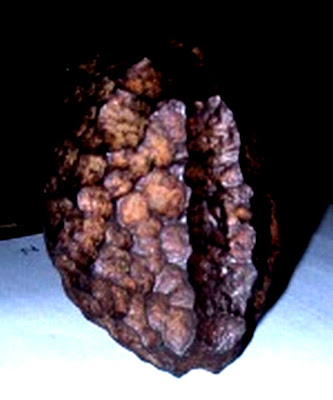
In the year 1885 AD, a workman named Reidl, who worked at a foundry in Schöndorf / Vöcklabruck (Austria), founded by Isidor Braun (1801-1866), broke open a block of brown coal that had been mined at Wolfsegg. He found an unusual metal cube/ cuboid like object embedded in the block.
The Tertiary coal deposit in which it had been embedded is generally dated to about 60 million years ago.
The workman Reidl, and/or his work mates must have found the metal object unusual and significant because they took it to their boss. The son of Isidor Braun, the mines founder, took the artifact to the Heimathaus (Museum) in Vöcklabruck. In 1886, the mining engineer Adolf Gurlt (Professor of Geology at the University of Bonn) suggested that it was meteoritic in origin.
A cast is kept in the Oberosterreichisches Landesmuseum in Linz, where the original object was exhibited from 1950 to 1958. In 1966-67, the object was analysed by at the Vienna Naturhistorisches Museum, using electron-beam microanalysis, which found no traces of nickel, chromium or cobalt in the iron, suggesting that it is not of meteoric origin, while the lack of sulphur shows that it is not a pyrites. Because of its low magnesium content, Dr Gero Kurat (born 1938) of the Museum and Dr Rudolf Grill (1910-1987) of the Geologische Bundesanstalt of Vienna thought it might be cast iron. A further investigation by Hubert Mattlianer, in 1973, concluded that it had been cast using the cire perdue (lost wax) technique.
Some say that the edges were sharp and straight, and there was little doubt that this was a machine made instrument that seemed part of a much larger instrument. It was made of iron, carbon, and a trace of nickel. The cube measured 2 1/2" by 1 4/5", weighed 28 oz., and had an incision that ran around it horizontally.
Here is another description:
"The object was almost a cube, with two of its opposing faces slightly rounded. It measured 67 mm by 47 mm, being this last measure taken between the two rounded off faces. It weighed 785 grams. A very deep incision surrounded it. Its composition age of hard steel with nickel and carbon. It did not contain sulphur, and thus he was not pyrite."
The cube was said to have a specific gravity of 7.75.
No comments:
Post a Comment